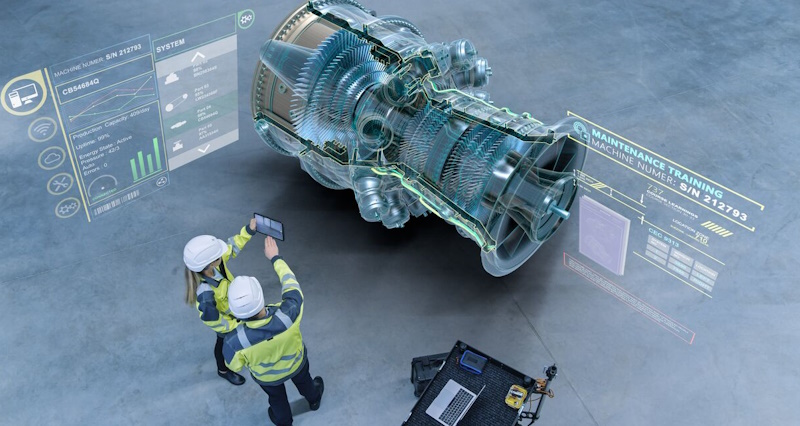The Industrial metaverse doesn’t exist yet but the building blocks are in place – Forrester research report August 2023
It’s common to hear the metaverse described as a 3D experience layer of the internet. The “industrial metaverse” is a more difficult concept to define. According to Forrester, it’s an umbrella term for a collection of different technologies. Some of those technologies have existed for years just waiting to come together.
Following on from our previous blog on the topic, Understanding the industrial Metaverse, in this blog we take an introductory look at the 4 building blocks, highlighting some of the key issues.
Real-Time Collaboration
As much a defining characteristic as a building block, real-time collaboration is a crucial prerequisite to the industrial metaverse. At its core, the metaverse is a communication tool, a way of sharing ideas and data. It enables individuals or teams to work together across physical distances using digital technologies.
When we think of the metaverse we think of cutting-edge virtual reality tools, but often the technology has existed for decades. Microsoft has been in this space since at least 1996 with its NetMeeting software which included desktop and file sharing alongside video conferencing. The evolution of that technology is a vital part of the business environment. Many companies and products are competing in this market with offerings like video conferencing and workplace collaboration software.
From design and engineering to production, quality assurance and beyond, manufacturing is necessarily a collaborative process – there are lots of problems to solve throughout the product lifecycle. That makes it an ideal candidate for new collaborative tools like our own digital reality platform Nexus. In the past it was common to have teams of engineers with different specialisations all in the same building, working closely together. In one of our recent blogs we discussed how the process of digitalisation has brought huge benefits, but at a cost. That cost has been the fragmentation and separation of once close networks.
The concept of the industrial metaverse and the group of technologies behind it represent a solution turning that problem into a huge opportunity.
Reality Capture
The second building block, reality capture, involves the use of technologies like 3D scanning and LiDAR to enable detailed and accurate digital twins of physical environments or objects. That reality capture data also enables people to immerse themselves in visualisations of products, processes and even complex factory environments.
If you can make a close representation of the real world and bring it into a digital space, it unlocks a wealth of possibilities for one simple reason. What we design isn’t always what we make. The practices used in virtual engineering software or in CAD/CAM workflows, can be applied to more accurate and up-to-date representations captured from the real world to solve problems with confidence in an accurate virtual sandbox environment.
One of the most Illustrative applications for this technology is in factory design and layout. For example, modern automotive factories are some of the most complex production facilities in the world. We’re talking about a multistage process with thousands of individual tasks, often using highly specialised equipment. Think about the continuous movement of machinery, various conveyor systems, robotics, combined with human workflows with ergonomic considerations, and health and safety protocols, the list goes on.
By building a digital twin that combines simulations with reality capture, we can accurately reproduce every complex detail in a virtual space, then go in and experiment with different configurations creating and testing unlimited prototypes in a virtual space. In the past we created everything separately. When reality capture and real-time collaboration come together, that linear workflow, and all the problems associated with it, melt away.
Data Fabric
For real-time collaboration to work effectively, the processes behind them need to be secure and lightning-fast. With equipment-intensive operations like automotive manufacture, the industrial metaverse is potentially a very powerful tool. Each machine and every stage in the value chain through to the end of the product lifecycle is a node in a complex network and we can upgrade each to provide continuous, real-time data.
The data fabric or “transport layer” refers to the system that allows for data exchange and integration across the entire network. It’s the glue that links it all together or the foundation of the real industrial metaverse. It ensures that data from various sources is securely and efficiently transported and processed.
This is one of the areas of Industrial metaverse that is less well known, and less frequently discussed. Unsurprisingly, it’s here that we find many of the biggest challenges that will need to be addressed before the concept of an industrial metaverse becomes mainstream.
Data privacy, for example, is a huge concern for the industrial metaverse. With digital versions of products, processes and facilities, there will be ever greater requirements for cybersecurity. The consequences of a data breach could be devastating. It’s in this transport layer where we might begin to address the issue. Another hurdle is the bandwidth or data transfer rate. If a network is not able to cope with the quantities of data being shared the concept of real-time collaboration very quickly falls apart.
Ability to Connect Different Systems
Building on the previous point, Interoperability is the final building block of the industrial metaverse.
Without the ability to connect different systems together, the concept of an industrial metaverse would be so restricted as to be hardly useful at all. Openness is fundamental and an essential prerequisite for manufacturing transformation. An industrial metaverse would be composed of a potentially limitless series of data sources, feeding into the whole. These might come from any number of different or even competing suppliers. Discounting a viable data source would mean missing key information to visualise and use in the industrial metaverse app. That would make the whole thing less accurate or bring about sub-optimal decisions.
Interoperability of equipment and integration of data sources are essential for creating any kind of unified and cohesive industrial metaverse. This connectivity is how we go from a purely virtual reality space to one that offers a persistent, always-on, digital representation of the physical world. Any connected device is like a piece of a giant digital mosaic. We only get an accurate image when we connect everything. The more pieces there are, the higher the resolution of the final image.


















